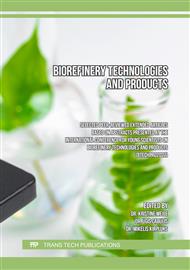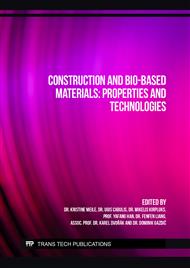[1]
R.S. Williams, Weathering of Wood in: R.M., Rowell (Eds.), Handbook of Wood Chemistry and Wood Composites, CRC Press, U.S., 2005, pp.139-185.
Google Scholar
[2]
C. Brischke, R. Bayerbach, A. Otto Rapp, Decay-influencing factors: A basis for service life prediction of wood and wood-based products, Wood Mater. Sci. Eng. 1 (2006) 91-107.
DOI: 10.1080/17480270601019658
Google Scholar
[3]
P.D. Evans, A.J. Michell, K.J. Schmalzl, Studies of the degradation and protection of wood surfaces, Wood Sci. Technol. 26 (1992) 151-163.
DOI: 10.1007/bf00194471
Google Scholar
[4]
N. Ayadi, F. Lejeune, F. Charrier, B. Charrier, A. Merlin, Color stability of heat-treated wood during artificial weathering, Holz als Roh und Werkstoff 61 (2003) 221-226.
DOI: 10.1007/s00107-003-0389-2
Google Scholar
[5]
H. Derbyshire, E.R. Miller, The photodegradation of wood during solar irradiation. Part 1. Effects on the structural integrity of thin wood strips, Holz als Roh und Werkstoff 39 (1981) 341-350.
DOI: 10.1007/bf02608404
Google Scholar
[6]
P.D. Evans, P.D. Thay, K.J. Schmalzl, Degradation of wood surfaces during natural weathering. Effects on lignin and cellulose and on the adhesion of acrylic latex primers, Wood Sci. Technol. 30 (1996) 411-422.
DOI: 10.1007/bf00244437
Google Scholar
[7]
A. Cogulet, P. Blanchet, V. Landry, Wood degradation under UV irradiation A lignin characterization, J. Photochem. Photobiol. B: Biol. 158 (2016) 184-191.
DOI: 10.1016/j.jphotobiol.2016.02.030
Google Scholar
[8]
I.T. Macleod, A.D. Scully, K.P. Ghiggino, P.J.A. Ritchie, O.M. Paravagna, B. Leary, Photodegradation at the wood–clearcoat interface, Wood Sci. Technol. 29 (1995) 183-189.
DOI: 10.1007/bf00204584
Google Scholar
[9]
R.P. Sigh, N.S. Tomer, S.V. Bhadraiah, Photo-oxidation studies on polyurethane coating: Effect of additives on yellowing of polyurethane, Polym. Degrad. Stab. 73 (2001) 443-446.
DOI: 10.1016/s0141-3910(01)00127-6
Google Scholar
[10]
N. Auclair, B. Riedl, V. Blanchard, P. Blanchet, Improvement of Photoprotection of Wood Coatings by Using Inorganic Nanoparticles as Ultraviolet Absorbers, For. Prod. J. 61 (2011) 20-27.
DOI: 10.13073/0015-7473-61.1.20
Google Scholar
[11]
B. Mahltig, H. Böttcher, K. Rauch, U. Dieckmann, R. Nitsche, T. Fritz, Optimized UV protecting coatings by combination of organic and inorganic UV absorbers, Thin Solid Films 485 (2005)108-114.
DOI: 10.1016/j.tsf.2005.03.056
Google Scholar
[12]
S. Saha, D. Kocaefe, C. Krause, T. Larouche, Effect of titania and zinc oxide particles on acrylic polyurethane coating performance, Prog. Org. Coat. 70 (2011) 170-177.
DOI: 10.1016/j.porgcoat.2010.09.021
Google Scholar
[13]
D. Cirule, E. Sansonetti, I. Andersone, E. Kuka, B. Andersons, Enhancing thermally modified wood stability against discoloration, Coatings 11 (2021) 1-13.
DOI: 10.3390/coatings11010081
Google Scholar
[14]
F.R. Kabir, D.D. Nicholas, R.C. Vasishth, H.M. Barnes, Laboratory methods to predict the weathering characteristics of wood, Holzforschung 46 (1992) 395-401.
DOI: 10.1515/hfsg.1992.46.5.395
Google Scholar
[15]
F.X. Perrin, M. Irigoyen, E. Aragon, J.L. Vernet, Evaluation of accelerated weathering tests for three paint systems: A comparative study of their aging behaviour, Polym. Degrad. Stab. 72 (2001) 115-124.
DOI: 10.1016/s0141-3910(01)00005-2
Google Scholar
[16]
S. Brunner, P. Richner, U. Muller, O. Guseva, Accelerated weathering device for service life prediction for organic coatings, Polym. Test. 24 (2005) 25-31.
DOI: 10.1016/j.polymertesting.2004.08.001
Google Scholar
[17]
B. Hinderliter, S. Croll, Monte carlo approach to estimating the photodegradation of polymer coatings, J Coat Technol Res 2 (2005) 483-491.
DOI: 10.1007/bf02733891
Google Scholar
[18]
J. Van den Bulcke, J. Van Acker, M. Stevens, Experimental and theoretical behaviour of exterior wood coatings subjected to artificial weathering, J. Coat. Technol. Res. 5 (2008) 221-231.
DOI: 10.1007/s11998-007-9074-4
Google Scholar
[19]
M.C. Morais, H. Pereira, Variation of extractives content in heartwood and sapwood of Eucalyptus globulus tree, Wood Sci. Technol. 46 (2012) 709-719.
DOI: 10.1007/s00226-011-0438-7
Google Scholar
[20]
M. de Meijer, K. Thurich, H. Militz, Comparative study on penetration characteristics of modern wood coatings, Wood Sci. Technol. 32 (1998) 347-365.
DOI: 10.1007/bf00702791
Google Scholar
[21]
L. Tolvaj, O. Faix, Artificial Ageing of Wood Monitored by DRIFT Spectroscopy and CIE L*a*b* Color Measurements. 1. Effect of UV Light, Holzforschung 49 (1995) 397-404.
DOI: 10.1515/hfsg.1995.49.5.397
Google Scholar
[22]
U. Müller, M. Rätzsch, M. Schwanninger, M. Steiner, H. Zöbl, Yellowing and IR-changes of spruce wood as a result of UV irradiation, J. Photochem. Photobiol. B: Biol. 69 (2003) 97-105.
DOI: 10.1016/s1011-1344(02)00412-8
Google Scholar
[23]
F. Bertaud, B. Holmbom, Chemical composition of earlywood and latewood in Norway spruce heartwood, sapwood and transition zone wood, Wood Sci. Technol. 38 (2004) 245-256.
DOI: 10.1007/s00226-004-0241-9
Google Scholar
[24]
B. Esteves, J. Gominho, J. Rodrigues, I. Miranda, H. Pereira, Pulping Yield and Delignification Kinetics of Heartwood and Sapwood of Maritime Pine, J. Wood Chem. Technol. 25 (2005) 217-230.
DOI: 10.1080/02773810500366656
Google Scholar
[25]
I. Miranda, V. Sousa, J. Ferreira, H. Pereira, Chemical characterization and extractives composition of heartwood and sapwood from Quercus faginea, PLoS ONE 12 (2017) e0179268.
DOI: 10.1371/journal.pone.0179268
Google Scholar
[26]
M. Kishino, T. Nakano, Artificial weathering of tropical woods. Part 1: Changes in wettability, Holzforschung. 58 (2004) 552-557.
DOI: 10.1515/hf.2004.084
Google Scholar
[27]
M.A. Kalnins, W.C. Feist, Increase in wettability of wood with weathering, For. Prod. J. 43 (1993) 55-57.
Google Scholar



